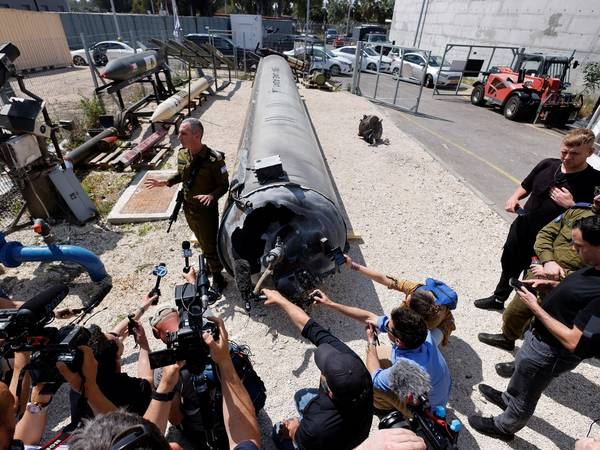The Israeli army on Tuesday pulled out an 11-meter (36-foot) long remnant of one of the Iranian ballistic missiles that had crashed into the Dead Sea following the large-scale Sunday attack and showed it to reporters.
The Islamic Republic has remained silent on the type of missiles used in the early Sunday morning attack, leaving the details shrouded in secrecy. However, by analyzing Israeli military reports and combining them with open-source intelligence, analysts suggest that one of the missiles might have been an Emad (Imad) missile. The Israel Defense Forces (IDF) spokesperson confirmed that only the fuel tank of the intercepted missile was recovered, as the warhead and engine were destroyed by the long-range Arrow air defense system.
According to the Israeli army, the recovered debris represents 70% of the original projectile's length. Analysis of released photographs and statements aligns with the specifications of Iran's Emad missile. The Emad, according to Iranian Revolutionary Guard-affiliated media, is a 15.5-meter ballistic missile. Ballistic missiles follow a curved trajectory, leveraging gravity to achieve extreme velocities. The Israel Defense Forces (IDF) estimate the missile traveled over 1,500 kilometers from Iran to Israel in roughly 12 minutes, reaching a speed of approximately 7,500 km/h, or roughly Mach 6.
Named after Imad Mughniyeh, the second-in-command of Hezbollah who was killed in 2008, the missile is manufactured by the Iranian defence ministry and underwent its first test launch in 2015. Just a few months ago, the IRGC conducted a simulated military operation, demolishing the mock Palmachim Airbase in Israel using Emad missiles.
Which missiles did Iran deploy in its assault on Israel?
IRGC-affiliated media have revealed details about the variety of missiles used in the attack on Israel. This included ballistic missiles such as the Khorramshahr, Sejjil, Ghadr, and Emad, alongside cruise missiles like the Paveh and the hypersonic Fattah. However, inconsistencies arose within official Iranian channels. For example, one newspaper suggested that Iran held back from deploying the Fattah hypersonic missiles, potentially reserving more advanced weapons for a future counter-attack. Amir Ali Hajizadeh, the commander of the IRGC Aerospace Forces, claimed on Thursday that the IRGC used its older models in the attack.
Setting the Scene: Exploring the Context
The Islamic Republic of Iran currently boasts the most extensive and varied ballistic missile arsenal in the Middle East. Iran's pursuit of ballistic missiles predates the Islamic revolution in 1979. However, it was during the Iran-Iraq War, fueled by animosity towards the West and their refusal to supply spare parts for Iran's dwindling air force after the monarchy's fall, that Tehran significantly ramped up its missile program.
Chronicles of Iran's Missile Campaign
- 1980S: During the eight-year war with Iraq, Tehran primarily deployed Soviet-made Scud B missiles.
- 1994-2001: Iran launched the Shahab-1, a domestically developed variant of the Scud B missile, with a range of 300 km (185 miles), targeting bases in Iraq used by the Mujahedin-e Khalq (MEK), an Iranian dissident organisation.
- Major attack since 2017:
Since 2017, Iran has launched missiles towards other countries on at least twelve occasions. These attacks involved over 300 ballistic and cruise missiles primarily targeting regional Muslim-majority nations. Iraq, bordering Iran, bore the brunt of these attacks, while Israel received the highest number of missiles.
Many strikes were launched in retaliation for perceived provocations against Iran, but the targeted nations often remained silent. This silence likely stemmed from a lack of military capability or willingness to respond, as seen in Iraq and Syria. Notably, Pakistan stood out for its swift and decisive response to an Iranian missile attack.
What Comes Next?
In its attack on Israel, Iran launched more than 300 killer drones, cruise missiles, and ballistic missiles on Israeli territory. Only four ballistic missiles successfully made it through the defences, with none of the cruise missiles or drones managing to do so, said Israel defence minister Yoav Gallant.
Now with the region in the brink of war, Israel stands at a crossroads. It faces the choice between a military strike on Iranian soil or diplomatic patience for future benefit. The absence of an attack may likely result in a false sense of victory for the Islamic Republic, while a military strike on Iranian soil could potentially drag the region into full-scale conflict. Meanwhile, the Islamic Republic stands on edge, bracing for Israel's next move.
